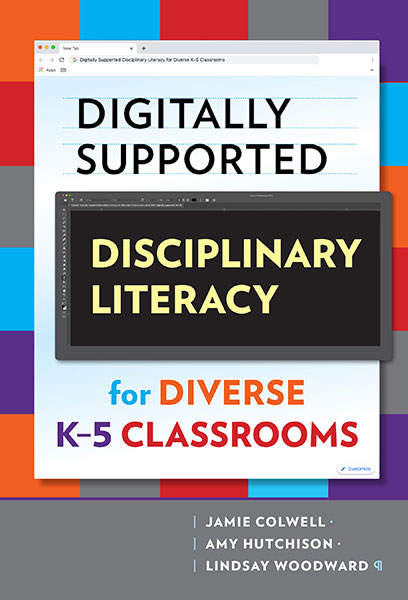Professors: Request an Exam Copy
Print copies available for US orders only. For orders outside the US, see our international distributors.
Jamie Colwell, Amy Hutchison, Lindsay Woodward
Foreword by: Tom Bean
Publication Date: July 10, 2020
Pages: 168
Series: Language and Literacy Series

This practical resource will help K–5 teachers incorporate digitally supported disciplinary literacy practices into their classroom instruction. With an emphasis on reaching all learners, the authors present Planning for Elementary Digitally supported Disciplinary Literacy (PEDDL)—a six-phase framework that introduces readers to an approach for integrating disciplinary literacy into instruction using various types of digital tools to support literacy learning. Including instructional methods and lesson plans, the text demonstrates how the tools can be incorporated into English language arts, mathematics, science, and social studies classrooms. Included are core practices for disciplinary literacy learning, along with the rationale behind each, and examples of the PEDDL Framework in action.
Book Features:
Jamie Colwell is an associate professor at Old Dominion University. Amy Carter Hutchison is associate professor and director in the Division of Elementary, Literacy, and Secondary Education at George Mason University. Lindsay Woodward is an assistant professor at Drake University.
“This noteworthy and practitioner-focused book would be a great addition for a classroom teacher’s library or on an elementary methods course reading list.”
—Teachers College Record
“Through this text, the authors provide rich, yet practical resources for K-5 teachers and teacher educators to broaden their knowledge and expertise to incorporate digitally supported disciplinary literacy instruction.”
—Journal of Language and Literacy Education
“I was very impressed with the way the authors put three very ‘hot topics’ together, explained how they connect, and laid out a clear, highly detailed teaching framework that makes use of those connections. I also really liked the authors’ reassurance that since the Core Disciplinary Practices are standards-aligned, teachers need only to extend what they are already teaching to include a disciplinary literacy element, using the PEDDL Framework to guide them.”
—Illinois Reading Council Journal
“This is a rich resource designed to transform elementary literacy teaching in powerful ways. . . . If we want to enable future citizens to participate as ‘insiders’ in a discipline, to critically analyze claims and assertions, and to represent and communicate information using digital tools, then the curriculum changes advocated in this book seem more important than ever.”
—Thomas W. Bean, Rosanne Keeley Norris Endowed Professor, Old Dominion University
“Teachers must have the know-how to prepare students to be thoughtful consumers and producers of 21st-century texts. This important book contributes a systematic framework for designing the type of effective digitally supported disciplinary instruction needed. Of particular interest are the explicit examples provided throughout, illustrating how the authors’ ideas can be seamlessly incorporated into a variety of elementary-level learning environments.”
—Rachel Karchmer-Klein, associate professor, University of Delaware
Contents (Tentative)
Introduction
1. Digital Tools to Support Disciplinary Literacy in Diverse K-5 Classrooms: An Overview
What Is Disciplinary Literacy?
Why Disciplinary Literacy in K-5?
How Is Disciplinary Literacy Different Than Content Area Literacy?
A Brief Note on Text
The Challenges of Disciplinary Literacy in K-5
The Goals of Disciplinary Literacy in Grades K-5
How Can Digital Tools Support K-5 Disciplinary Literacy in Diverse K-5 Classrooms?
What Does Current Research Suggest?
Core Disciplinary Practices as an Approach to Disciplinary Literacy
2. The PEDDL Framework
Planning for Disciplinary Literacy in Elementary Grades
PEDDL Framework Overview
Phase 1: Identifying Appropriate Disciplinary Literacy Practices
Phase 2: Framing Disciplinary Literacy
Phase 3: Selecting Multimodal Texts for Disciplinary Literacy
Phase 4: Assessing Disciplinary Literacy with a Variety of Tools
Phase 5: Digitally Supporting Disciplinary Literacy Instruction
Phase 6: Reflecting to Reach All Learners
Considerations for Diverse Learners in the PEDDL Framework
General Ideas for Practice
3. Examining Disciplinary Literacy in Elementary English Language Arts
Integrating Disciplinary Literacy into ELA
How Can Disciplinary Literacy Instruction Be Digitally Supported in ELA?
4. Practical Approaches to Digitally -Supported Disciplinary Literacy in ELA
Sample Lesson: Examining Culturally Diverse Fairy Tales Through Literary Text Analysis in 2nd Grade
Questions to Ponder
5. Examining Disciplinary Literacy in Elementary Mathematics
Integrating Disciplinary Literacy Into Mathematics
How Can Disciplinary Literacy Instruction Be Digitally Supported in Mathematics?
6. Practical Approaches to Digitally -Supported Disciplinary Literacy in Mathematics
Sample Lesson: Representing and Explaining Addition in Kindergarten
Questions to Ponder
7. Examining Disciplinary Literacy in Elementary Science
Integrating Disciplinary Literacy Into Science
How Can Disciplinary Literacy Instruction Be Digitally Supported in Science?
8. Practical Approaches to Digitally -Supported Disciplinary Literacy in Science
Sample Lesson: Evidence-Based Account of Illumination in 1st Grade
Questions to Ponder
9. Examining Disciplinary Literacy in Elementary Social Studies
Integrating Disciplinary Literacy Into Social Studies
How Can Disciplinary Literacy Instruction Be Digitally Supported in Social Studies?
10. Practical Approaches to Digitally -Supported Disciplinary Literacy in Social Studies
Sample Lesson: Comprehending Multiple Types of Texts to Better Understand U.S. Colonial Life in 5th grade
Questions to Ponder
11. Closing Thoughts and Tips for Planning
Long-Range Planning
Time, Time, Time
Designing Instruction That is Appropriate for All Students
Introducing New Digital Tools to Students
Discrepancies Across Grades K-5
Explicit Disciplinary Literacy Instruction
Establishing a Professional Learning Network
Final Remarks
References
Index
About the Authors
Download Appendix in PDF format.
Professors: Request an Exam Copy
Print copies available for US orders only. For orders outside the US, see our international distributors.